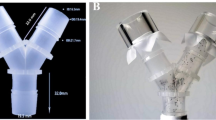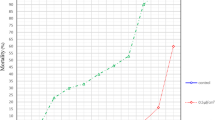Abstract
An oil extracted from the leaves of a tropical shrub Ocimum suave was found to repel as well as kill all stages of the tick Rhipicephalus appendiculatus. In an in vitro bioassay for the larvae, the LC50 of the oil in liquid paraffin was 0.024%. A 10% solution was found to kill all immatures and more than 70% of adults feeding on rabbits. Rabbits were protected for 5 days against attaching larvae using a 10% solution. Preliminary experiments undertaken with cattle kept in the field suggest that the oil may have potential in tick control, and a role in integrated tick management.
Similar content being viewed by others

References
Burg, R.W., Miller, B.M., Baker, E.E., Birnbaum, J., Curie, S.A., Hartman, R., Kang, Y.L., Monaghan, R.L., Olson, G., Putter, I., Tunac, J.B., Wallick, H., Stapley, E.O., Oiwa, R. and Omura, S., 1979. Avermectins, new family of potent antihelmintic agents: producing organism and fermentation. Antimicrobial Agents and Chemotherapy, 15: 361–367.
Chema, S., 1984. Public sector responsibility in tick control programme. In: FAO seminar on African Centres for Tick and Tick-borne Disease control, p. 11.
Chogo, J.B. and Crank, G., 1981. Chemical composition and biological activity of the Tanzanian plant Ocimum suave. J. Nat. Prod., 44: 308–311.
Cremlyn, R., 1978. Pesticides, preparation and mode of action. J Wiley and Sons, New York. pp. 39–49.
Dipeolu, O.O., 1991. Current approach to control of ticks on livestock at the ICIPE, Kenya. In: F.Dusbabek, and Bukva, V. (eds), Modern Acarology, 1: 219–228. Academia, Prague.
Dipeolu, O.O. and Ndungu, J.N., 1991. Acaricidal activity of Kupetaba, a ground mixture of natural products, against Rhipicephalus appendiculatus. Vet. Parasitol., 38: 327–338.
FAO Report, 1984. Acaricide resistance. In: Ticks and tick-borne disease control. A practical field manual Volume 1: 246–299.
Hassanali, A., Lwande, W., Ole-Sitayo, N. and Moreka, L., Nokoe, S. and Chapya, A., 1990. Weevil repellent constituents of Ocimum suave leaves and Eugenia caryophyllata cloves used as grain protectants in parts of Eastern Africa. Discovery and Innovation, 2: 91–95.
Kokwaro, J.O., 1976. Medicinal plants of East Africa. Nairobi. East African Literature Bureau.
Malonza, M.M., Dipeolu, O.O., Amoo, A.O. and Hassan, S.M., 1992. Laboratory and field observation on anti-tick properties of the plant Gynandropsis gynandra L. Brig. Vet. Parasitol., 42: 123–136.
Matthewson, M.D., 1984. The future of tick control: A review of the chemical and non-chemical options. Preven. Vet. Med., 2: 559–568.
Niyonzema, A. and Kiltz, H.H., 1986. Control of ticks and tick-borne diseases in Burundi. In: Sutherst, R. (Editor), Ticks and Tick-borne Diseases. Proceedings of an International Workshop on the Ecology of Ticks and Epidemiology of Tick-borne Diseases, Zimbabwe. ACIAR Proc. No. 17 pp. 16–17.
Pegram, R.G., Chizyuka, H.G.B., Mwase, E.T. and Zekle, Z., 1988. Production economics in worldwide animal commodities subject to disease transmission and infestation by acarines: The economic impact of cattle tick control in Central Africal Paper presented at the National Symposium on Theileriosis, 17–19 October 1988, Lusaka, Zambia.
Simpkin, J and Galun, R., 1983. Microencapsulated natural pyrethrum—an improved repellent. In: Whitehead, D.L. and Bowers, W. (eds) Natural Products for Innovative Pest Management. Pergamon Press, pp. 151–164.
Stone, B.F. and Haydock, K.P., 1962. A method for measuring the acaricide susceptibility of the cattle tick Boophilus microplus (Can.). Bul. Entomol. Res., 53: 563–578.
Sutherst, R.W., Jones, R.J. and Schnitzerling, H.J., 1982. Tropical legumes of the genus Stylosanthes immobilize and kill cattle ticks. Nature (London), 295: 320–321.
Sutherst, R.W. and Wilson, L.J., 1986. Tropical legumes and their ability to immobilize and kill cattle ticks. In: Juniper, B.C. and Southwood, T.R.E. (eds) Insects and the plant surface, pp. 185–194.
Sutherst, R.W., Wilson, L.J., Reid, R. and Kerr, J.D., 1988. A survey of the ability of tropical legumes in the genus Stylosanthes to trap larvae of the cattle tick, Boophilus microplus (Ixodidae). Austr. J. Exp. Agric., 28: 473–479.
Thompson, K.C., Roa, E.J. and Romero, N.T., 1978. Anti-tick grasses as the basis for developing practical tropical tick control package. Trop. Amin. Health Prod., 10: 179–182.
Watt, J.M. and Brever-Brandwijk, M.G., 1962. The Medicinal and Poisonous Plants of Southern and Eastern Africa. London: E. and S. Livingstone Ltd, pp. 35–40.
Author information
Authors and Affiliations
Rights and permissions
About this article
Cite this article
Mwangi, E.N., Hassanali, A., Essuman, S. et al. Repellent and acaricidal properties of Ocimum suave against Rhipicephalus appendiculatus ticks. Exp Appl Acarol 19, 11–18 (1995). https://doi.org/10.1007/BF00051933
Issue Date:
DOI: https://doi.org/10.1007/BF00051933



